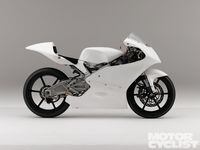When the final 250cc MotoGP season ended in 2009, Aprilia had taken the manufacturer’s title but Honda’s Hiroshi Aoyama became the last world champion. Aoyama’s RS250, like the competitive Aprilia RSV250, was an amazing machine, producing about 100 horsepower from a normally aspirated V-twin and weighing not much more than 200 pounds. But these two-strokes, at their peak of development, were also at the end of their road, a dead-end in terms of emissions and commercial viability. Thus they were replaced by the new Moto2 600cc four-strokes.
Fast-forward one year: Honda introduces its new CBR250R at the Thailand International Motor Expo in Bangkok. On the surface, it may seem strange to even compare Aoyama’s championship-winning racebike to this new streetbike with its estimated 23 horsepower and 359-pound wet weight. Are there any connections besides the Honda name? And why introduce this bike at an obscure Asian show?
In performance terms, the CBR is not very exciting, but the bike represents the beginning of a new developmental path for Honda, and for the industry in general, that may take some very interesting turns.
First, Honda describes the 250 as a "world bike". Initially, at least, it will be built in Thailand, which explains the Asian introduction. But the intention is to sell the bike in every world market and, depending on where sales are strongest, possibly shift manufacturing to another country. Honda’s goal is, of course, to maximize profits by making the bike cheaply and selling a lot of them. In the past it’s been possible to make bikes for individual markets, but Honda has been looking at the worldwide recession and has apparently decided that what’s worked in the past may not be a good model for the future.
So the company is following a new business model, and it makes sense that it’s begun exploring that with an entry-level product. This beginner’s bike does, however, have some high-end features. The styling reflects the VFR1200F’s "floating" fairing-panel look and headlight treatment. The liquid-cooled, DOHC engine is a slice off the CBR1000RR, with identical bore/stroke and comparable valve sizes. Unusually for a bike this small, there’s a counterbalancer. Where previously there might have been carbureted versions in markets where emissions regulations aren’t as tight, these 250s will all have fuel injection. Still more unusually, the CBR will be available with ABS, this option pushing the cost up just $500 from the base MSRP of $3999.
Even with all its bells and whistles, however, this single will be pretty slow. What’s to excite the sporting instincts? There are some interesting convergences here...
For one, Honda builds another 250cc four-stroke single, the CRF250R, with plenty of sporting credentials. The CRF makes somewhere around 35 bhp and weighs about 225 lbs. Admittedly it’s a motocrosser, and much of its technology won’t readily cross over to the street. But the point to keep in mind is that the engineers working on the CRF’s development are working on a package familiar to the CBR’s engineers. The team working on the two-stroke twins was almost in another world from the four-stroke teams. Not anymore.
In another convergence, the forthcoming Moto3 rules will require the smallest MotoGP class to run 250cc singles starting next year. Thus the development teams for this new NSF250R, the CRF250R and the CBR250R will all be working to optimize similar four-stroke singles. There will certainly be differences determined by the end uses, but in terms of technical features such as reduction of friction and other losses, combustion-chamber development, fuel-injection hardware/software and many others, the teams will be working along the same lines and will likely support each other.
I would imagine that by the start of the first Moto3 season, a Honda NSF250R will be making close to 50 bhp and weigh just over 200 lbs. Moreover, as the racebike is developed, the streetbike will likely inherit some of its features. With the two-stroke racers, what raced on Sunday couldn’t be sold on Monday. With the new four-strokes, we’ll get some very sporting Monday hardware before too long.MC











/cloudfront-us-east-1.images.arcpublishing.com/octane/VZZXJQ6U3FESFPZCBVXKFSUG4A.jpg)
/cloudfront-us-east-1.images.arcpublishing.com/octane/QCZEPHQAMRHZPLHTDJBIJVWL3M.jpg)
/cloudfront-us-east-1.images.arcpublishing.com/octane/HXOUJXQWA5HBHGRO3EMJIGFMVI.jpg)

/cloudfront-us-east-1.images.arcpublishing.com/octane/3TIWWRV4JBBOLDVGRYECVVTA7Y.jpg)
/cloudfront-us-east-1.images.arcpublishing.com/octane/KIX5O23D5NAIBGFXBN3327DKZU.jpg)
/cloudfront-us-east-1.images.arcpublishing.com/octane/7GJYDUIPXRGMTMQKN6ONYOLBOU.jpg)
/cloudfront-us-east-1.images.arcpublishing.com/octane/MUQLOVLL2ZDGFH25ILABNBXKTI.jpg)
/cloudfront-us-east-1.images.arcpublishing.com/octane/TNOU5DNE2BC57MFPMGN2EIDXAM.jpg)
/cloudfront-us-east-1.images.arcpublishing.com/octane/GTCXACQGJ5HAPDTGWUQKDEH44E.jpg)
/cloudfront-us-east-1.images.arcpublishing.com/octane/S35YGSEMEZB4BLTDJTSZPF4GLA.jpg)
/cloudfront-us-east-1.images.arcpublishing.com/octane/5UOT6HPX2JFMRJAX6EH45AR4MQ.jpg)
/cloudfront-us-east-1.images.arcpublishing.com/octane/OKWOJWAKP5EP3OACCRRWPCIX2Q.jpg)
/cloudfront-us-east-1.images.arcpublishing.com/octane/2WF3SCE3NFBQXLDNJM7KMXA45E.jpg)
/cloudfront-us-east-1.images.arcpublishing.com/octane/G4MG6OUCJNBSHIS2MVVOTPX65E.jpg)
/cloudfront-us-east-1.images.arcpublishing.com/octane/IIGGWFOTOJGB7DB6DGBXCCMTDY.jpg)
/cloudfront-us-east-1.images.arcpublishing.com/octane/QSTCM6AVEZA5JJBUXNIQ3DSOF4.jpg)
/cloudfront-us-east-1.images.arcpublishing.com/octane/U4I7G625B5DMLF2DVIJDFZVV6M.jpg)
/cloudfront-us-east-1.images.arcpublishing.com/octane/B6XD6LS6IVCQPIU6HXDJSM3FHY.jpg)
/cloudfront-us-east-1.images.arcpublishing.com/octane/ICL63FEDDRDTTMINYICCEYGMDA.jpg)
/cloudfront-us-east-1.images.arcpublishing.com/octane/FCGZHQXRBZFLBAPC5SDIQLVF4I.jpg)
/cloudfront-us-east-1.images.arcpublishing.com/octane/WNOB6LDOIFFHJKPSVIWDYUGOPM.jpg)

/cloudfront-us-east-1.images.arcpublishing.com/octane/X33NU3E525ECRHXLNUJN2FTRKI.jpg)